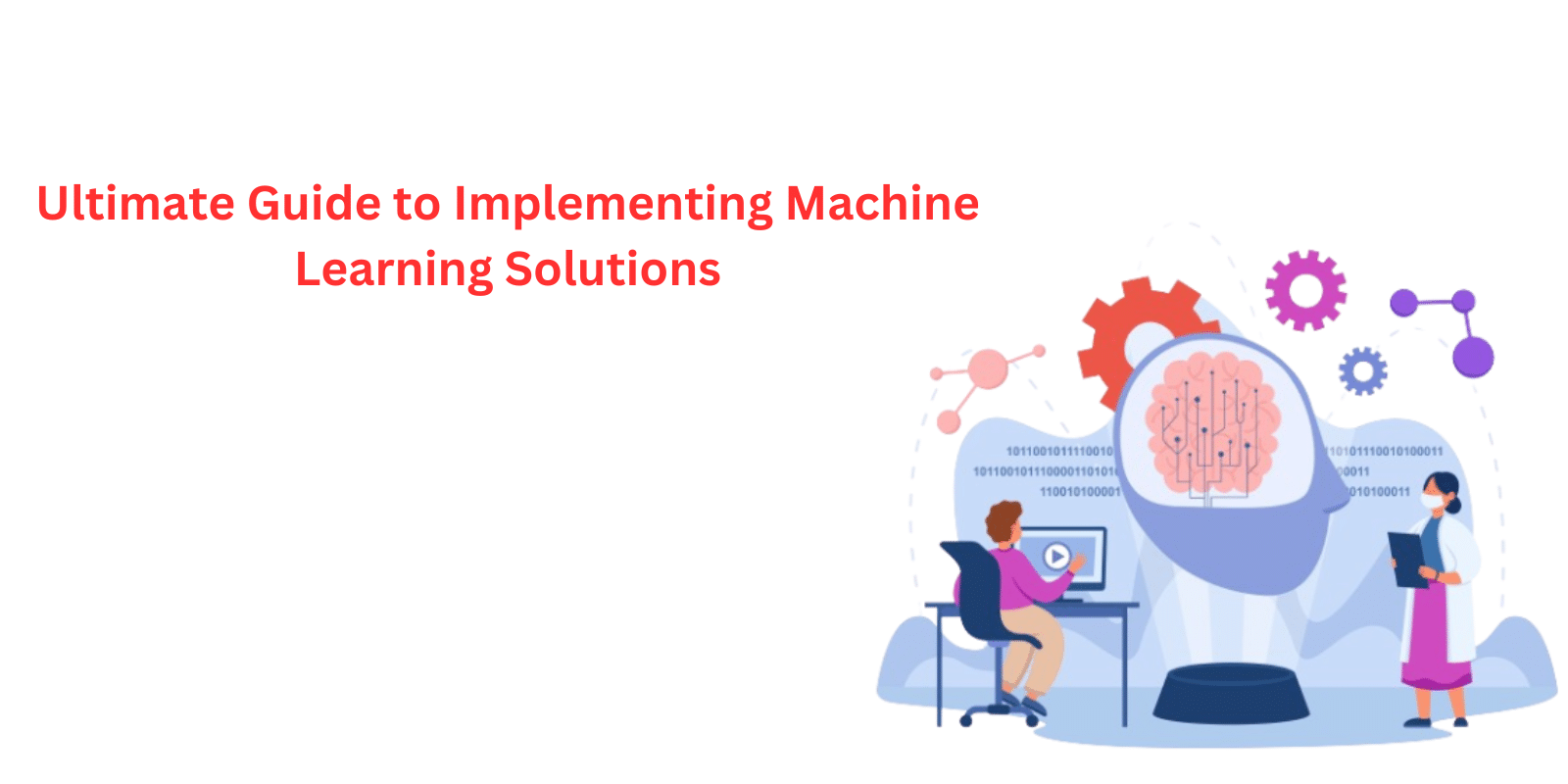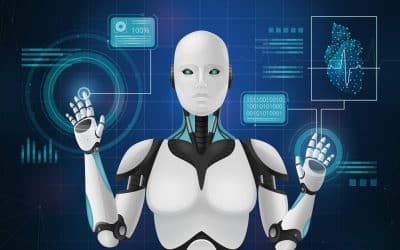AI has been around for a long time, but it became the talk of the town when it was accessible to mass audiences through LLMs (Large Language Models). OpenAI played a significant role by releasing Chatgpt. Businesses are rapidly adopting Artificial intelligence solutions that make their businesses more predictive and automated and foster innovation.
ML is the technology that oversees most machine intelligence. Data is the heart of Machine Intelligence, and It is essential to implement the right strategy to make a model on top of this data, which can give fruitful outcomes from data. You must ensure the machines gain the apt knowledge to move further and become intelligent.
Did you know that over 90% of global data has been created within two years? As such, Machine Learning Solutions models that identify patterns in data and make decisions have become essential tools for businesses today. Organizations of all industries across all sectors are approaching one of the most significant disruptions to hit business since the Industrial Revolution, while many still need to prepare. In this blog post, we present you with a simple yet practical pattern that you can utilize when employing value-generating AI and machine-learning solutions to resolve virtually all business challenges.
What Is Machine Learning (ML)?
ML is a technology where machines learn automatically by studying past experiences and data to make predictions or draw inferences without human input or supervision. Machine learning methods enable computers to operate autonomously without explicit programming, learning to process new information autonomously to grow, adapt, and thrive independently. When fed new data sets, machine learning applications can learn independently as new pieces arrive – adapting by themselves.
Machine learning algorithms extract valuable insights from large amounts of data by employing algorithms to recognize patterns and learn through iterative iterations. They use computation methods for direct data processing rather than depending on predetermined equations that might act as models.
Machine learning algorithms’ performance continuously adapts to increased available samples during their ‘learning’ processes, with adaptively increasing results with each successive sample available for evaluation. On the other hand, deep learning employs computational models that train computers to mimic natural human traits, such as learning from examples, offering better performance parameters than standard machine learning algorithms.
Machine learning has existed since World War II, when the Enigma Machine was used. However, its modern implementation, involving complex mathematical calculations automatically applied to growing volumes and varieties of available data, is relatively recent.
Project Lifecycle For Machine Learning
This cycle comprises six sequential steps. Each is distinct and may require different resources, time commitment, and team members to complete. Let’s investigate each component to understand its significance in our life cycles.
Problem Understanding
Each project begins with a problem you must solve, which should be clearly and numerically described. Numbers help define your starting point while simultaneously tracking any effects of changes made later on. Companies utilize calculations that display the cost of each manual operation to the business, helping us prioritize our operations based on cost efficiency.
Recently, one management team unveiled a machine learning project designed to automate one particular manual operation currently on our spending list. This team also conducted extensive research into and benchmarked this operation’s costs against those of competitors.
The results could have been even better: similar manual operations at other companies in our industry are up to 20% less expensive—that was their motivation behind initiating an automation project to compete successfully in the market. However, knowing costs only solves some things; the machine learning team must address them before coming up with solutions.
So far, the business-centric definition has only made sense. However, to fully take advantage of machine learning technology, we need to move away from financial units in favor of KPIs, which our machine learning team better understands.
To achieve that goal, the management determined that to reduce manual operation costs by 20%, at least 70% fewer manual processes would need to be conducted manually compared with 100% before 30% more operations would be processed automatically – meaning 30% should be processed automatically! Knowing this helps project teams narrow their scope while understanding that only specific components must be addressed instead of tackled head-on.
Next, the team broke down the manual task we wanted to automate into its component parts and estimated their respective time and money costs; once they had done so, they created a list of tasks they thought might be automated for further consideration by management.
After discussing this list with their Machine Learning Consulting Companies, they identified several tasks that, if adequate data were made available, could be handled using supervised machine learning algorithms.
Finalizing problem understanding requires collaboration across your company. Each team should know exactly who and why it targets what. Once that step has been accomplished, projects may commence.
Data Collection
Collecting data when the problem is straightforward and an appropriate machine-learning strategy has been identified is vital. In other words, progress is essential when the issue can be easily tackled using machine learning.
Data comes from multiple sources. Your internal database could contain valuable data that you could query directly for relevance. Data engineers could extract that data, or you could use existing services like Amazon Mturk to make extraction more manageable.
Other professionals collect client data directly, typically when working together on solving a client problem directly. The client is invested in the outcome and is willing to share assets like data sets with their consultant.
Another option worth exploring is purchasing data from third-party providers like Nielsen Media Research (NMR). NMR specializes in the FMCG (fast-moving consumer goods) market and conducts extensive market research from different populations of its target markets. It collects valuable customer and preference data that companies selling fast-moving consumer goods need to ride emerging trends into profitability and understand customers more fully. So third-party data providers like NMR can be an excellent source for crucial insight.
Open-source datasets are also widely available and can be especially handy when dealing with general business and industry problems that impact multiple sectors and companies at once. You might find the data set you require on the Internet; many come from government organizations, while some originate at public companies or universities.
Public datasets also often come with annotations (when applicable), making manual operations significantly faster and cheaper for you and your team. Use this article as a guide in finding the right publicly available dataset for your project:
Your goal should be to collect as much relevant data as possible. When talking about tabular data, this typically entails collecting samples over an extended time span. Keep this in mind: the more samples you gather, the stronger your future models will be.
Data Preparation
Later in your project life cycle, data preparation could drastically decrease your number of samples, minimizing this possibility and ensuring an abundance of samples for later analysis. That’s why it’s vital that as much data can be acquired now as possible at its inception. But also bear in mind: Data Prep.
Data collected can be unstructured. Machine learning engineers require assistance when dealing with raw data. Each dataset presents unique challenges when it comes to data preprocessing. A rule of thumb should be established when approaching creative and multifaceted techniques like missing value removal. Machine Learning engineers can remove these values, leaving only valid records to work with in their datasets.
Alternative approaches involve filling records with nonexistent values via imputation. Unfortunately, there’s no easy solution here either. You may need to input multiple times depending on your criteria. Mathematical algorithms for imputing also vary, and there may even be different techniques you could try!
Another consideration for machine learning engineers is creating new features from existing ones; this practice is known as data engineering. As soon as your data preparation is complete, data preprocessing (also known as prefetching or data cleansing) should make your information digestible for your neural net or algorithm you are training. Typically, this involves normalization, standardization, and scaling steps.
Data Annotation
If your work involves supervised learning, each sample in your dataset requires labels assigned. This process of assigning labels to data samples is known as data annotation or labeling. Data annotation is an intensive manual operation that often falls to third parties for completion, although machine learning engineers sometimes help label data sets themselves. As most likely, none of your team will undertake annotation alone, at this step, it should be your goal to devise an all-encompassing annotation guideline document.
Guidelines will guide annotators in doing their jobs correctly, so a comprehensive job guide must be created that encompasses every essential aspect. Be wary of edge cases during labeling; your annotation team needs to be aware and prepared for every possible scenario that might come their way; there needs to be somewhere for people who help with annotation duties to take place if anything becomes unclear and opaque in any job they undertake; additionally, assign someone as support personnel assisting the annotations team if need be.
Modeling
Machine Learning Development Companies and engineers don’t typically develop models from scratch; instead, they repurpose models that have proven successful on large public datasets. Pre-trained models may then be fine-tuned using deep learning’s popular fine-tuning strategy, deep reinforcement learning (DRL), such as CNNs, which extract low-level features useful across tasks. This form of fine-tuning works particularly well when applied to computer vision, as CNNs produce features with similar qualities for all functions that must be extracted simultaneously.
Model ZOOs, otherwise known as places where public pre-trained models can be found publicly and pre-loaded onto servers for training, are an excellent source for pre-trained models with hundreds of options available on GitHub alone. Search by architecture or framework you work to locate an ideal model ZOO solution.
Noting the necessity of customizing imported pre-trained models to reflect our specific task is of paramount importance.
Computer vision users should remember this: A classification model’s ability to detect specific classes depends on its top-part architecture, where dense layers should contain units equal to your desired class distinction number. To distinguish those classes successfully, you need a final model architecture design suitable to your goals.
Evaluation must occur alongside experiments. You need to know how each model performs before selecting the top performer; a set of metrics must also be defined to compare models effectively.
Your metrics depend upon the problem you’re working on. When considering regression problems, MSE or MAE is often chosen. Accuracy provides a good evaluation for classifying models used on balanced datasets, while the F1 score may provide more suitable metrics in cases involving unbalanced sets with more sophisticated characteristics.
Evaluation during training takes place using a separate validation dataset, monitoring how effective our model is at generalization while avoiding possible bias and overfitting issues.
Visualizing model progress during training jobs is always beneficial and essential to their overall workflow success. Tensorboard provides a simple yet basic option; more sophisticated tools such as Neptune.AI allow experiment tracking. Investing time and consideration when selecting an experiment-tracking solution tailored specifically for you and your workflow goals is invaluable – you may save both time and improve overall efficiency with their help!
Deployment
Deployment marks the last stage in machine learning’s life cycle, yet our work must continue unabated. Otherwise, we risk becoming idle while waiting for new projects to start up again.
Once deployed, models require ongoing evaluation to ensure they continue providing the quality required by business. We all recognize some negative side effects may arise over time, one of which is model degradation.
Another effective practice would be collecting samples that your model has mishandled to isolate the cause. Then, using this knowledge to retrain and make the model more resistant to such samples, such ongoing research can provide a greater understanding of possible edge cases or unexpected situations your current model cannot handle.
Machine Learning Objective & Metric Best Practices
The first obvious step is defining the business objective before beginning the ML model design. However, many times, ML models are started without clearly defined goals. Such models are set for failure because the ML models need clearly defined goals, parameters, and metrics. Organizations may need to be made aware of setting specific objective goals for ML models. They may want to find insights based on the available data, but more than a vague goal is needed to develop a successful ML model. You must be clear about your objective and the metric to measure success. Otherwise, you’ll save time on the right thing or chase an impossible goal.
Here are some objective best practices to keep in mind when designing the objectives of your machine-learning solutions:
Ensure The ML Model Is Necessary
While many organizations want to follow the ML trend, the Machine Learning Model Validation may need to be more profitable. Before investing time and resources into developing an ML model, you need to identify the problem and evaluate whether machine learning and MLOps will be helpful in the specific use case.
Small-scale businesses must be even more careful because ML models cost resources that may not be available. Identifying areas of difficulty and having relevant data to implement machine learning solutions is the first step to developing a successful model. It is the only way to improve the profitability of the organization.
Collect Data For The Chosen Objective
Even though use cases are identified, data availability is the crucial factor in determining the successful implementation of the ML model. An organization’s first ML model should be simple but choose objectives supported by a large amount of data.
Develop Simple & Scalable Metrics
First, begin by constructing use cases for which the ML model must be created. Based on the use cases, technical and business metrics have to be developed. The ML model can perform better when there is a clear objective and metrics to measure those objectives. The current process to meet the business goal must be reviewed thoroughly. Understanding where the current process faces challenges is the key to automation. Identifying deep learning techniques that can solve the current challenges is crucial.
Final Thoughts
Machine learning enables computers to learn, memorize, and generate accurate outputs. It has enabled companies to make informed decisions critical to streamlining their business operations. Such data-driven decisions help companies across industry verticals, including manufacturing, retail, healthcare, energy, and financial services, optimize their current operations while seeking new methods to ease their overall workload.
Following the best practices, you can create a scalable, customizable, and resilient ML model that requires minimal modification. Ideal ML models integrate seamlessly with existing systems. The ML model should always be improved as the business requirements and data change continuously.











